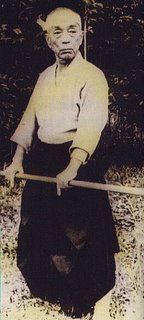
Trying to decipher kata (solo practice forms, usually of Chinese origin in karate styles) is akin to interpreting the Bible, and often can get you in as much trouble. Bunkai officially translates as kata's application, although explanation is probably a better word. In kumite, fighting full bore all the time has its obvious drawbacks. Employing true martial waza during sparring is definitely not socially responsible behavior. So to maintain the original fire that a traditional art was forged in, we have kata. Kata, specifically bunkai, reminds us that the martial arts are of a very serious nature. When Okinawans were denied the right to bear arms at various times throughout their violent history (including the US military occupation following the second World War), the practice of kata became a stealthy option. Karate's earliest training sessions were shrouded in secrecy, and often took place after dark. So it should come as no surprise that kata was created, in part, to conceal its real purpose.
Attack/defense scenarios are presented in the kata one after another. Since the human brain is hard wired to retain information more efficiently by rote (like the telling of an old story, or learning a dance sequence), kata makes a superb training tool. Although it's rarely done, the bunkai should be revealed along side the teaching of the kata right away, for clarity's sake. Many of these ancient forms are so old, their meaning has been lost. Traditional practitioners should be aware that kata is not universally accepted in combative systems. Muay Thai kickboxing, for example, which has a history that actually pre-dates Okinawan karate, does not include forms in its teachings. The relevance or need for kata is largely questioned in martial arts circles, and remains as one of the more controversial topics of discussion amongst practitioners today.
Labels: kata, military, Okinawa, sparring-kumite, styles







